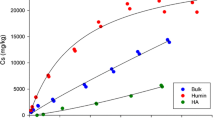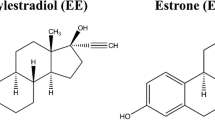Abstract
This study investigated the sorption behaviour of two endocrine disrupting chemicals; 17β-estradiol (E2) and 17β-ethinylestradiol and their thermodynamic properties in an activated sludge biomass. The partition coefficient values measured for E2 and EE2 at varying temperatures range from 245–604 L/kg ( log Kd 2.39–2.78) and 267–631 L/kg (Log Kd 2.43–2.80), respectively. The Kd values were inversely related to temperature. The average percentages of E2 and EE2 adsorbed to the solid phase at 4.3 % dry solid were 87.2 % and 92.5 %, respectively. Sorption of E2 and EE2 to the activated sludge biomass was found to be spontaneous and entropy retarded with ΔG values in the range of −13 to −16 KJ/mol and ΔS value of−105.2J/mol/K and 96.7 J/mol/k for E2 and EE2, respectively. The enthalpy changes for E2 and EE2 were −45.7KJ/mol and −43.4KJ/mol respectively, demonstrating that the sorption process is exothermic. The values of the enthalpy changes also show that the mechanism of sorption is physisorption with some element of chemisorption.
Similar content being viewed by others
References
Abdel Ghani, N.; Elchaghaby, G. A., (2007). Influence of operating conditions on the removal of Cu, Zn, Cd and Pb ions from wastewater by adsorption., Int. J. Environ. Sci. Tech., 4(4), 451–456 (6 pages).
Abdel-Ghani, N. T.; Hegazy, A. K.; El-Chaghaby, G. A., (2009). Typha domingensis leaf powder for decontamination of aluminium, iron, zinc and lead: Biosorption kinetics and equilibrium modeling. Int. J. Environ. Sci. Tech., 6(2), 243–248 (6 pages).
Andersen, H.; Siegrist, H.; Halling-Sorensen, B.; Ternes, T. A., (2003). Fate of estrogens in a municipal sewage treatment plant. Environ. Sci. Tech., 37(18), 4021–4026 (6 pages).
Andersen, H. R.; Hansen, M.; Kjolholt, J.; Stuer-Lauridsen, F.; Ternes, T.; Halling-Sorensen, B., (2005). Assessment of the importance of sorption for steroid estrogens removal during activated sludge treatment. Chemosphere, 61(1), 139–146 (8 pages).
Annamalai, K.; Puri, K. I., (2002). Advanced Thermodynamics Engineering. Boca Raton, FL, CRC Press.
Bonin, J. L.; Simpson, M. J., (2007). Sorption of steroid estrogens to soil and soil constituents in single- and multi-sorbate systems. Environ. Toxic. Chem., 26(12), 2604–2610 (7 pages).
Chen, X.; Hu, J., (2009). Degradation of 17β-estradiol and its conjugates: Effects of initial concentration and MLSS Concentration. Process Biochem., 44(12), 1330–1334 (5 pages).
Chen, D. Z.; Zhang, J. X.; Chen, J. M., (2010). Adsorption of methyl tert-butyl ether using granular activated carbon: Equilibrium and kinetic analysis. Int. J. Environ. Sci. Tech., 7(2), 235–242 (8 pages).
Clara, M.; Strenn, B.; Saracevic, E.; Kreuzinger, N., (2004). Adsorption of bisphenol-A, 17â-estradiol and 17á-ethinylestradiol to sewage sludge. Chemosphere, 56(9), 843–851 (22 pages).
Combalbert, S.; Hernandez-Raquet, G, (2010). Occurrence, fate, and biodegradation of estrogens in sewage and manure. Appl. Microbiol. Biotech. 86(6), 1671–1692 (22 pages).
Feng, Y.; Zhang, Z.; Gao, P.; Su, H.; Yu, Y.; Ren, N., (2010). Adsorption behaviour of EE2 (17α-ethinylestradiol) onto the inactivated sewage sludge: Kinetics, thermodynamics and influence factors. J. Hazard. Mater., 175(1–3), 970–976 (7 pages).
Gomez, M. J.; Martinez Bueno, M. J; Lacorte, S.; Fernandez-Alba, A. R.; Aguera, A., (2007). Pilot survey monitoring pharmaceuticals and related compounds in a sewage treatment plant located on the Mediterranean coast. Chemosphere, 66(6) 993–1002 (10 pages).
Gong, R.; Liang, J.; Chen, J.; Huang, F., (2009). Removal of bisphenol A from aqueous solution by hydrophobic sorption of hemimicelles Int. J. Environ. Sci. Tech., 6(4), 539–544 (6 pages).
Hashimoto, T.; Murakami, T., (2009). Removal and degradation characteristics of natural and synthetic estrogens by activated sludge in batch experiments. Water Res., 43(3), 573–582 (10 pages).
Huang, C. H.; Sedlak, D. L., (2001). Analysis of estrogenic hormones in municipal wastewater effluent and surface water using enzyme-linked immunosorbent assay and gas chromatography/tandem mass spectroscopy. Environ. Toxicol. Chem., 20(1), 133–139 (7 pages).
Ifelebuegu, A. O.; Lester, J. N.; Churchley, J.; Cartmell, E., (2006). Removal of an endocrine disrupting chemical (17α-ethyloestradiol) from wastewater effluent by activated carbon. Environ. Tech., 27(12), 1343–1349 (7 pages).
Ivashechkin, P.; Corvini, P. F. -X.; Dohmann, M., (2004). Behaviour of endocrine disrupting chemicals during the treatment of municipal sewage sludge. Water Sci. Tech., 50(5), 133–140 (8 pages).
Jobling, S.; Nolan, M.; Tyler, C. R.; Brighty, G. C.; Sumpter, J. P., (1998). Widespread sexual disruption in wild fish. Environ. Sci. Tech., 32(17), 2498–2506 (9 pages).
Kanda, R.; Churchley, J., (2008). Removal of endocrine disrupting chemicals during conventional wastewater treatment. Environ. Tech., 29(3), 315–323 (9 pages).
Keenan, H. E.; Sakultantimetha, A.; Bengkedphol, S.,(2008) Environmental fate and partition co-efficient of oestrogenic compounds in sewage treatment process. Environ. Res., 106(3), 313–318 (6 pages).
Kreuzinger, N.; Clara, M.; Strenn, B.; Kroiss, H., (2004). Relevance of the sludge retention time (SRT) as design criteria for waste water treatment plants for the removal of endocrine disruptors and pharmaceuticals from waste water. Water Sci. Tech., 50(5), 149–156 (8 pages).
Kumar, A. K.; Mohan, S. V.; Sarma, P.N., (2009). Sorptive removal of endocrine-disruptive compound 9estriol, E(3) from aqueous phase by batch and column studies: kinectic and mechanistic evaluation. J. Hazard. Mater., 164(2-3), 820–828 (9 pages).
Lai, K. M.; Johnson, K. L.; Scrimshaw, M. D.; Lester, J. N., (2000). Binding of waterborne steroid estrogens to solid phases in river and estuarine systems. Environ. Sci. Tech., 34(18), 3890–3894 (5 pages).
Langford, K.; Lester, J. N., (2003). Fate and behaviour of endocrine disrupters in wastewater treatment processes. In: Birkett, J. W. and Lester, J. N., (Eds.), Endocrine Disrupters in Wastewater and Sludge Treatment Processes, Lewis Publishers and IWA Publishing, London, UK.
Nakada, N.; Tanishima, T.; Shinokara, H.; Kiri, K.; Takada, H., (2006). Pharmaceutical chemicals and endocrine disrupters in municipal wastewater in Tokyo and their removal during activated sludge treatment. Water Res., 40(17), 3297–3303 (7 pages).
Plósz, B. G.; Leknes, H.; Liltved, H.; Thomas, K. V., (2010). Diurnal variations in the occurrence and the fate of hormones and antibiotics in activated sludge wastewater treatment in Oslo, Norway. Sci. Total Environ., 408(8), 1915–1924 (10 pages).
Ren, Y.; Nakano, K.; Nomura, M.; Chiba, N.; Nishimura, O., (2007). A thermodynamic analysis on adsorption of estrogens in activated sludge process. Water Res., 41(11), 2341–2348 (8 pages).
Rosal, R.; Rodríguez, A.; Perdigón-Melón, J. A.; Petre, A.; Garcia-Calvo, E.; Gómez, M. J.; Agüera, A.; Fernández-Alba, A. R., (2010). Occurrence of emerging pollutants in urban wastewater and their removal through biological treatment followed by ozonation. Water Res., 44(2), 578–588 (11 pages).
Schaar, H.; Clara, M.; Gans, O.; Kreuzinger, N., (2010). Micropollutant removal during biological wastewater treatment and a subsequent ozonation step. Environ. Pollut., 158(5), 1399–1404 (6 pages).
Schafer, A. I.; Mastrup, M.; Lund Jensen, R., (2002). Particle interaction and removal of trace contaminants from water and wastewaters. Desalination, 147(1–3), 243–250 (8 pages).
Schwarzenbach, R. P.; Gschwend, P. M.; Imboden, D. M., (2003). Environmental Organic Chemistry. Wiley, New York.
Soltanali, S.; Shams Hagani, Z., (2008). Modeling of air stripping from volatile organic compounds in biological treatment processes. Int. J. Environ. Sci. Tech., 5(3), 353–360 (8 pages).
Stasinakis, A. S.; Kordoutis, C. I.; Tsiouma, V. C.; Gatidou, G.; Thomaidis, N. S., (2010). Removal of selected endocrine disrupters in activated sludge systems: Effect of sludge retention time on their sorption and biodegradation. Bioresour. Tech., 101(7), 2090–2095 (6 pages).
Ternes, T. A.; Herrmann, N.; Bonerz, M.; Knacker, T.; Siegrist, H.; Joss, A., (2004). A rapid method to measure the solid-water distribution coefficient (Kd) for pharmaceuticals and musk fragrances in sewage sludge. Water Res., 38(19), 4075–4084 (10 pages).
USEPA, (1984). Definition and procedure for the determination of MDL: Revision 1.11, Fed. Rg, 49, 43430–43431.
Van Emmerik, T.; Angove, M. J.; Johnson, B. B.; Wells, J. D.; Fernandes, M. B., (2003). Sorption of 17β-estradiol onto selected soil minerals. J. Coll. Inter. Sci., 266(1), 33–39 (7 pages).
Weber, W. J. Jr.; DiGiano, F. A., (1996) Process dynamics in environmental systems. Wiley Publishers, New York.
Ying, G.; Kookana, R. S.; Dillon, P., (2003). Sorption and degradation of selected five endocrine disrupting chemicals in aquifer material. Water Res., 37(15), 3785–3791 (7 pages).
Yoochatchaval, W.; Ohashi, A; Harada, H.; Yamaguchi, T.; Syutsubo, K., (2008). Characteristics of Granular Sludge in an EGSB Reactor for Treating low Strength Wastewater. Int. J. Environ. Res., 2(4), 319–328 (10 pages).
Yoon, Y.; Westerhoff, P.; Snyder S. A.; Esparza M., (2003). HPLC-fluorescence detection and adsorption of bisphenol A, 17β-estradiol, and 17â-ethynyl estradiol on powdered activated carbon. Water Res., 37(14), 3530–3537 (8 pages).
Author information
Authors and Affiliations
Corresponding author
Rights and permissions
About this article
Cite this article
Ifelebuegu, A.O., Theophilus, S.C. & Bateman, M.J. Mechanistic evaluation of the sorption properties of endocrine disrupting chemicals in sewage sludge biomass. Int. J. Environ. Sci. Technol. 7, 617–622 (2010). https://doi.org/10.1007/BF03326171
Received:
Revised:
Accepted:
Published:
Issue Date:
DOI: https://doi.org/10.1007/BF03326171




